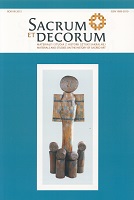Tempus passionis według Stanisława Kulona
Tempus passionis according to Stanisław Kulon
Author(s): Renata Rogozińska Contributor(s): Grażyna Ryba (Editor)
Subject(s): History, Fine Arts / Performing Arts, Theology and Religion
Published by: Wydawnictwo Uniwersytetu Rzeszowskiego
Keywords: Stanisław Kulon; drawing; sculpture; Polish martyrology; Second World War; religious art; Easter inspirations
Summary/Abstract: The text discusses several sculptures and drawings by Stanisław Kulon on the theme of the martyrology of the Polish nation. The first to be analysed are the drawings depicting the Volhynian massacres (2010), a cycle of autobiographical bas-reliefs Testimony 1939-1946, showing the ordeal of Polish deportees to the Urals (2013), and twenty-eight bas-reliefs The Way of the Cross (1991), which conflate the fate of Poles at the Soviet labour camps with references to Christ’s suffering and death on the cross. The conviction that he had a moral lesson to teach – which rules out ambiguity and the temptation to let one’s imagination run riot – made Kulon focus on the “bare facts” only and adopt a this-is-what-really-happened kind of approach. In lieu of the shorthand, symbol, and the radical deformities frequently employed in his previous work, they use a more quasi-documental style of narration in order to emphasise the enormity of the crime. The works show in drastic detail the tortures inflicted on the deportees and their gruelling work in the “inhuman land”. Martyrological themes are also present in Kulon’s other works, both religious and secular. They feature numerous references to the situation of Poles living under Soviet occupation and during the martial law in the years 1981–1983. The tragic view of the human condition is not without an appeal to a “higher power”. On the contrary, his belief in the supernatural status of man’s existence is often accentuated, thus revealing an eschatological perspective, especially in the sculptures inspired by the Passion of Christ. Regardless of its themes and modes of artistic creation, Kulon’s entire legacy shows a man entangled in a traumatic past, marked by the trauma of the genocide he witnessed and the years of captivity under the communist rule. Tekst jest omówieniem kilkunastu rzeźb oraz rysunków Stanisława Kulona o tematyce martyrologicznej. W pierwszej kolejności poddano analizie rysunki obrazujące rzeź Polaków na Wołyniu (2010), cykl autobiograficznych płaskorzeźb Świadectwo 1939–1946, ilustrujących katorgę zesłańców polskich na Uralu (2013), oraz 28 płaskorzeźb Droga krzyżowa (1991), w których losy Polaków w łagrach sowieckich zostały w splecione z męką i śmiercią krzyżową Jezusa Chrystusa. Poczucie moralnego posłannictwa, wykluczające wieloznaczność i wzbraniające się przed zakusami wyobraźni, doprowadziło Kulona do bezprecedensowego przedstawienia faktów, ujawnienia, że tak-oto-było. W miejsce skrótu, symbolu, obrazowania aluzyjnego, częstego we wcześniejszych okresach twórczości rzeźbiarza, pojawia się narracja quasi-dokumentalna, mająca na celu ujawnienie realnego wymiaru zbrodni. Twórca nie szczędzi więc drastycznych szczegółów, ukazując tortury, jakim poddawano ofiary i ich katorżniczą pracę „na nieludzkiej ziemi”. Treści martyrologiczne obecne są również w wielu innych dziełach Kulona, zarówno religijnych, jak i świeckich. Znaleźć w nich liczne można odniesienia do sytuacji Polaków pod okupacją sowiecką i w czasie stanu wojennego 1981–1983. Tragiczna wizja ludzkiego losu nie jest w nich jednak pozbawiona „wyższego adresu”. Przeciwnie, często dochodzi do głosu nadprzyrodzony status istnienia człowieka i ujawnia się perspektywa eschatologiczna, silnie wyeksponowana w rzeźbach o tematyce pasyjnej. Niezależnie jednak od podejmowanych tematów i sposobów ich artykulacji plastycznej, cały dorobek Kulona to w istocie dzieło człowieka uwikłanego w traumatyczną przeszłość, naznaczonego stygmatem doświadczonego ludobójstwa i zniewolenia przez reżim komunistyczny.
Journal: Sacrum et Decorum. Materiały i studia z historii sztuki sakralnej
- Issue Year: 2015
- Issue No: 8
- Page Range: 50-72
- Page Count: 23
- Language: English, Polish

